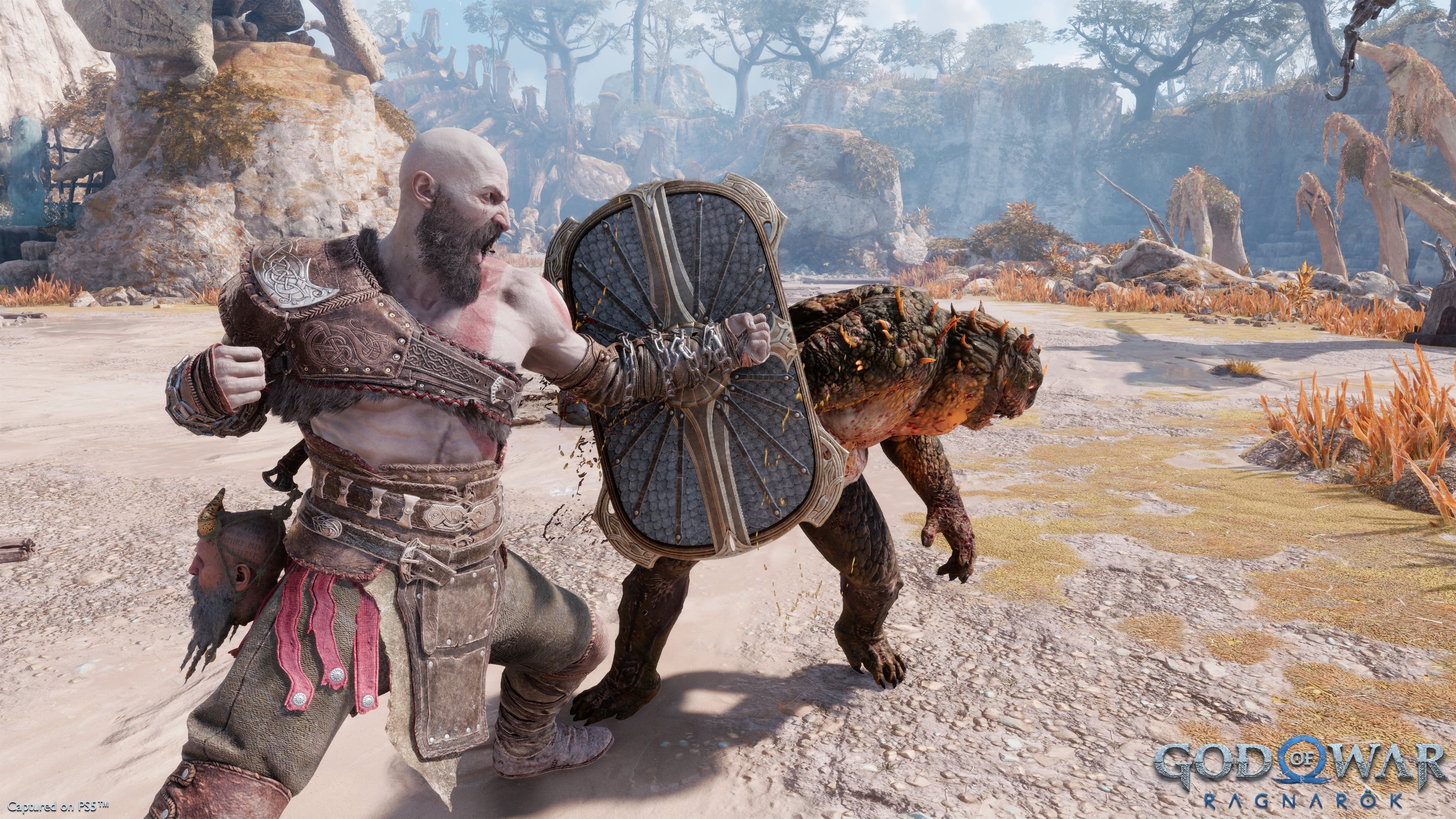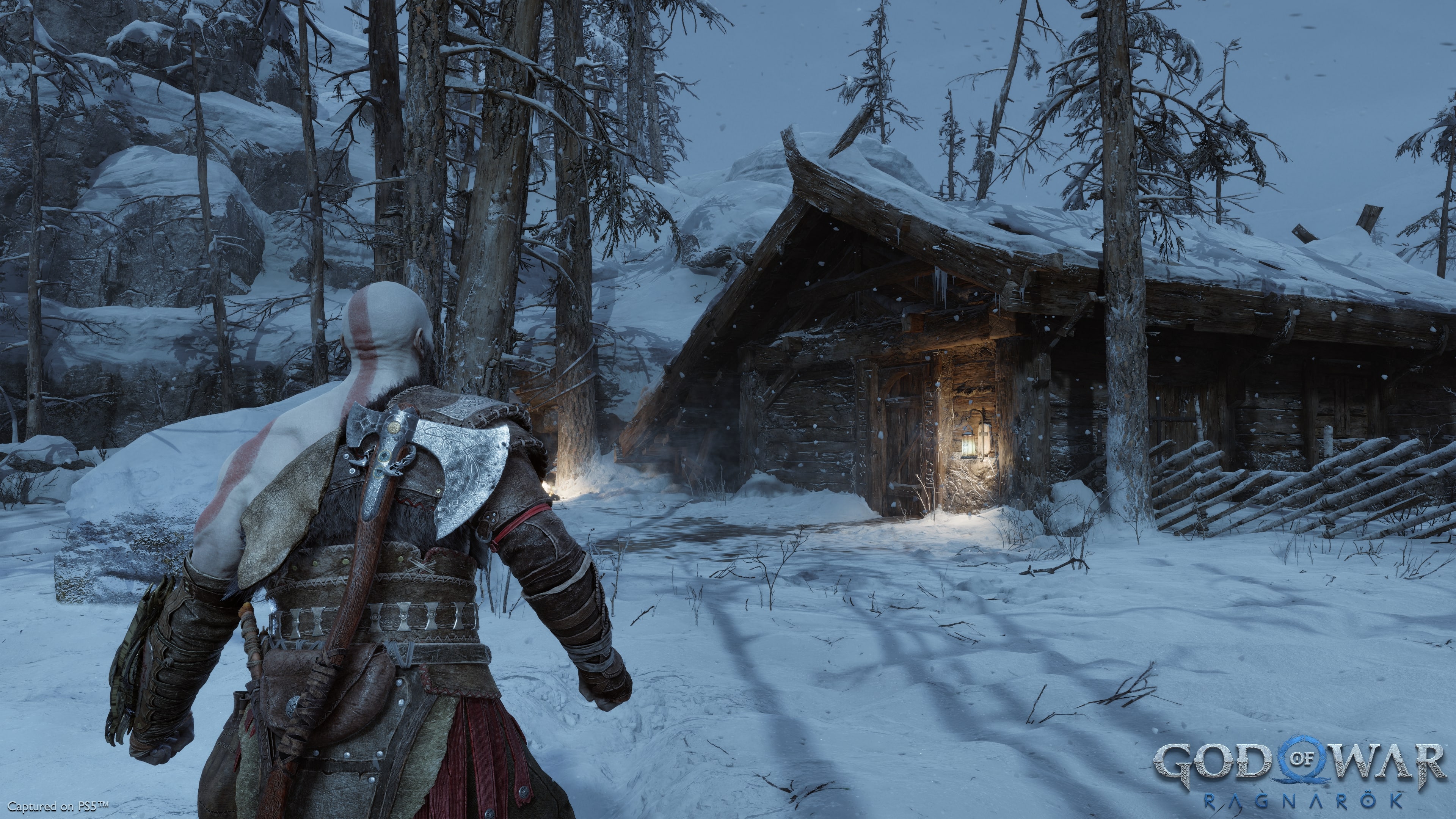God of War Ragnarök doesn’t make you wait for the good stuff
God of War Ragnarök’s early hours are chock full of memorable moments

This piece contains minor spoilers for the first few hours of God of War Ragnarök, and major spoilers for God of War (2018).
God of War Ragnarök begins with long-suffering protagonist Kratos sitting in a cave, reminiscing on his past and, presumably, pondering what the future might bring. It’s a calm, quiet moment that segues into a heartfelt conversation with his son Atreus, as the two mount a wolf-sled and ride back home through the gently falling snow. I wondered whether this God of War entry might break with series precedent and start with a slow burn rather than a bombastic action scene.
Then a murderous Norse god swoops down from above and stabs Kratos through the chest with a sword, while he and Atreus try to drive the sled through a sea of obstacles.
The over-the-top violence felt strangely comforting. As much as God of War (2018) changed the tone of the series from “epic Greek drama” to “contemplative Norse tragedy,” some things will always stay the same. There’s still a chaotic intro battle. The series still knows exactly when to go all-out, and when to let you catch your breath. And Kratos is still the man you go to when you need a god killed.
Over the past few nights, I’ve played through the early hours of God of War Ragnarök, and I didn’t realize just how much I’d missed this series. The level of craftsmanship on display here is rare, even in big-budget exclusive games. But more than that, I was impressed — and relieved — to discover that God of War Ragnarök front-loads a lot of cool stuff, just like its predecessors.
Building on a legend

What struck me about God of War Ragnarök is that it actually builds on the events of the previous game. That sounds like it should be self-evident in a sequel, but it’s not — even if you just consider previous games in the series. Kratos had similar arcs in a number of previous games, especially God of War II and III, which had nearly identical story structures.
By contrast, Ragnarök picks up where God of War (2018) left off, particularly when it comes to character development. A few years have passed since Kratos killed the beautiful Baldur, and in so doing, made a dire enemy of the god’s mother, Freya. Now Kratos is trying to train his teenage son, Atreus, to survive and fight. The two must survive Fimbulwinter — the snowy precursor to Ragnarök — the twilight of the Norse gods, and, potentially, the end of the world.
For whatever reason, I expected the rocky relationship between Kratos and Atreus to completely reset, since the previous game wrung so much drama out of it. But instead, the father and son have forged a sort of understanding based on mutual respect, if not exactly love. Atreus is learning to control his godly powers, and Kratos is encouraging the teen to do so. Their relationship is much less adversarial, and it feels rewarding to see how the two characters have rubbed off on each other over time. Atreus is more focused and serious, while Kratos is just a tiny bit more open with his feelings.
Another benefit of building on the previous game is that it doesn’t need much of an excuse to throw Kratos right into the thick of things. After a bit of exploration, combat and puzzles to establish the general flow of the game, God of War Ragnarök makes good on the postgame credits teaser from God of War (2018). You might remember that a thunderbolt awakened Kratos and Atreus, and they ran outside to find a huge, burly man with an enchanted hammer on his belt ready to greet them.
One of the first major boss fights in God of War Ragnarök is with Thor himself, and the game does not pull any punches. The god of thunder towers over even Kratos, and no matter how hard Kratos throws a punch, swings his axe or bashes with his shield, Thor doesn’t seem too fazed. The game does an excellent job of developing characters through how they behave in combat, and it’s clear right away how much of a threat Thor is. Every time you think the battle is over, it picks right up again, and in the end, it’s a well-earned — albeit temporary — victory.
The Nine Realms

God of War Ragnarök has more to offer during the first few hours than a single riveting boss fight, however. First off, it’s worth mentioning that the combat is nearly identical to God of War (2018)’s, and it’s just as good as it was before. The camera follows Kratos much more closely than in the Greek cycle games, giving battles a visceral and immediate feel. You can still maul your foes with light, heavy and ranged attacks; you can still call upon Atreus to riddle enemies with arrows. And you can still switch freely between the mighty Leviathan Axe and the iconic Blades of Chaos.
More than the combat, what struck me was just how much equipment you can find early on. After reconnecting with the quarrelsome dwarven blacksmiths Brok and Sindri, you can craft and/or upgrade weapons, armor and augments that affect your light and heavy attacks. Since you can also earn XP from enemy encounters and level up Kratos and Atreus’ abilities, you don’t have to wait too long before the two characters start feeling powerful again. (According to the wise talking head Mimir, Fimbulwiner sapped some of the abilities the two earned in the first game.)
The dwarves also give Kratos and Atreus a way to travel through the Nine Worlds of Norse myth once again, and it’s not long before they wind up in Svartalfheim: home of the dwarves. It may also be where the malicious god Odin imprisoned the Norse god of war, Tyr.
In Svartalfheim, the game opens up quite a bit, as you can pilot a boat around a big central lake, stopping at a variety of optional waypoints to take on side quests. (Sound familiar?) Without going into too much detail, one of these quests gave me enough resources to craft a legendary set of armor for Kratos — considerably better than the run-of-the-mill stuff I’d found so far. Not only did the set look striking, but it empowered Kratos’ attacks, gave him healing abilities and buffed his stats considerably. The previous game saved a lot of these powerful artifacts until closer to the end, and it’s rewarding to start building your arsenal in earnest early on.
Of course, this process may have some drawbacks as well. God of War Ragnarök may be as much fun as its predecessor, but it’s inherently a little less impressive, since we already know the “older, calmer Kratos on a quest with his son in the Norselands” paradigm works. The moment when Kratos reclaims the Blades of Chaos in God of War (2018) sent shivers down my spine; this time around, he just picks them up off of a shelf before he leaves his house.
Still, God of War Ragnarök is exactly what I wanted it to be so far. With brutal combat, gorgeous levels and a heartfelt story, it’s just what we’ve come to expect from this storied series. And if the game has this much good stuff up front, I can only imagine what comes next.
God of War will come out for the PS4 and PS5 on November 9, and will cost either $60 or $70, depending on your platform.
You can now read our full God of War Ragnarök review.
Sign up to get the BEST of Tom's Guide direct to your inbox.
Get instant access to breaking news, the hottest reviews, great deals and helpful tips.
Marshall Honorof is a senior editor for Tom's Guide, overseeing the site's coverage of gaming hardware and software. He comes from a science writing background, having studied paleomammalogy, biological anthropology, and the history of science and technology. After hours, you can find him practicing taekwondo or doing deep dives on classic sci-fi.

